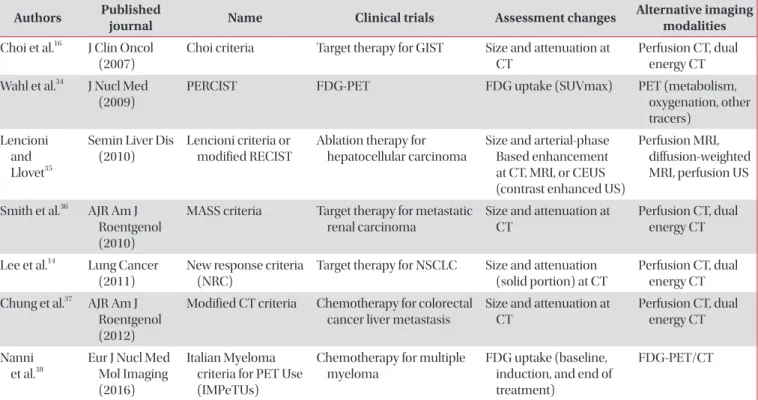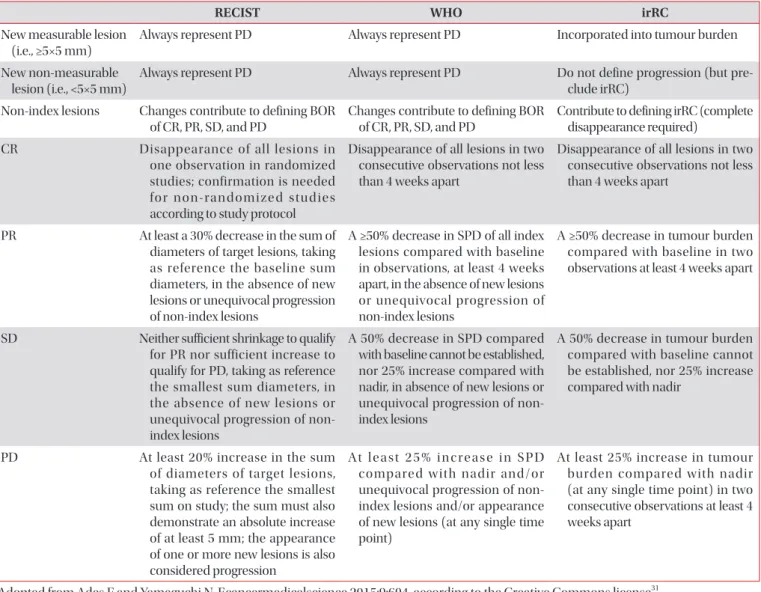Evaluation Criteria In Solid Tumor (RECIST) version 1.1, and introduction of new methods.
Timeline of Response Evaluation of Chemotherapy for Cancer
In 1979, World Health Organization (WHO) tried to invent standardize criteria of response assessment and early 1980s, WHO had published the first international standard criteria and had applied tumor response evaluating method to che- motherapy
1-3. Fundamentally, cytotoxic agents have a process on the basis of the amount of tumor shrinkage so that assess- ment to effect of chemotherapy has been investigated. Tumor size was traditionally assessed with bi-dimensional measure- ment which falls in to WHO guideline (the product of the lon- gest diameter and its longest perpendicular diameter for each tumor)
4. Measurability was defined as result that was recorded in metric notation using calipers or ruler. Response evaluation (applied WHO criteria) was performed and subjections were proposed. First, is about real measuring in bi-dimensions and afterwards products calculations were too complicated con- taining risk factors cause of theoretical variations of diameter were more correlated to the death cell’s fixed proportion of standard dose of chemotherapy rather than bi-dimensional product variations. Second, is weakness of reproducibility be-
Introduction
Anti-cancer drugs effect could be measured by assessing al- ternation in tumor size. Response evaluation of chemotherapy is clinical trials prospective end point which is a significant guideline of decision making for clinicians. Recently, there had been much development of imaging modality of new anti- cancer drug; however, the development of chemotherapies response evaluations is not. Thus, this review article will con- tain response evaluation methods that had been used after lung cancer patient’s chemotherapy, limitation of Response
Response Evaluation of Chemotherapy for Lung Cancer
Ki-Eun Hwang, M.D., Ph.D. and Hak-Ryul Kim, M.D., Ph.D.
Department of Internal Medicine, Institute of Wonkwang Medical Science, Wonkwang University School of Medicine, Iksan, Korea
Assessing response to therapy allows for prospective end point evaluation in clinical trials and serves as a guide to clinicians for making decisions. Recent prospective and randomized trials suggest the development of imaging techniques and introduction of new anti-cancer drugs. However, the revision of methods, or proposal of new methods to evaluate chemotherapeutic response, is not enough. This paper discusses the characteristics of the Response Evaluation Criteria In Solid Tumor (RECIST) version 1.1 suggested in 2009 and used widely by experts. It also contains information about possible dilemmas arising from the application of response assessment by the latest version of the response evaluation method, or recently introduced chemotherapeutic agents. Further data reveals the problems and limitations caused by applying the existing RECIST criteria to anti-cancer immune therapy, and the application of a new technique, immune related response criteria, for the response assessment of immune therapy. Lastly, the paper includes a newly developing response evaluation method and suggests its developmental direction.
Keywords: Evaluation Studies as Topic; Drug Therapy; Lung Neoplasms
Address for correspondence: Hak-Ryul Kim, M.D., Ph.D.
Department of Internal Medicine, Institute of Wonkwang Medical Science, Wonkwang University School of Medicine, 895 Muwang-ro, Iksan 54538, Korea
Phone: 82-63-859-2583, Fax: 82-63-855-2022 E-mail: kshryj@wku.ac.kr
Received: Jun. 28, 2016 Revised: Aug. 26, 2016 Accepted: Feb. 10, 2017
cc It is identical to the Creative Commons Attribution Non-Commercial License (http://creativecommons.org/licenses/by-nc/4.0/).

